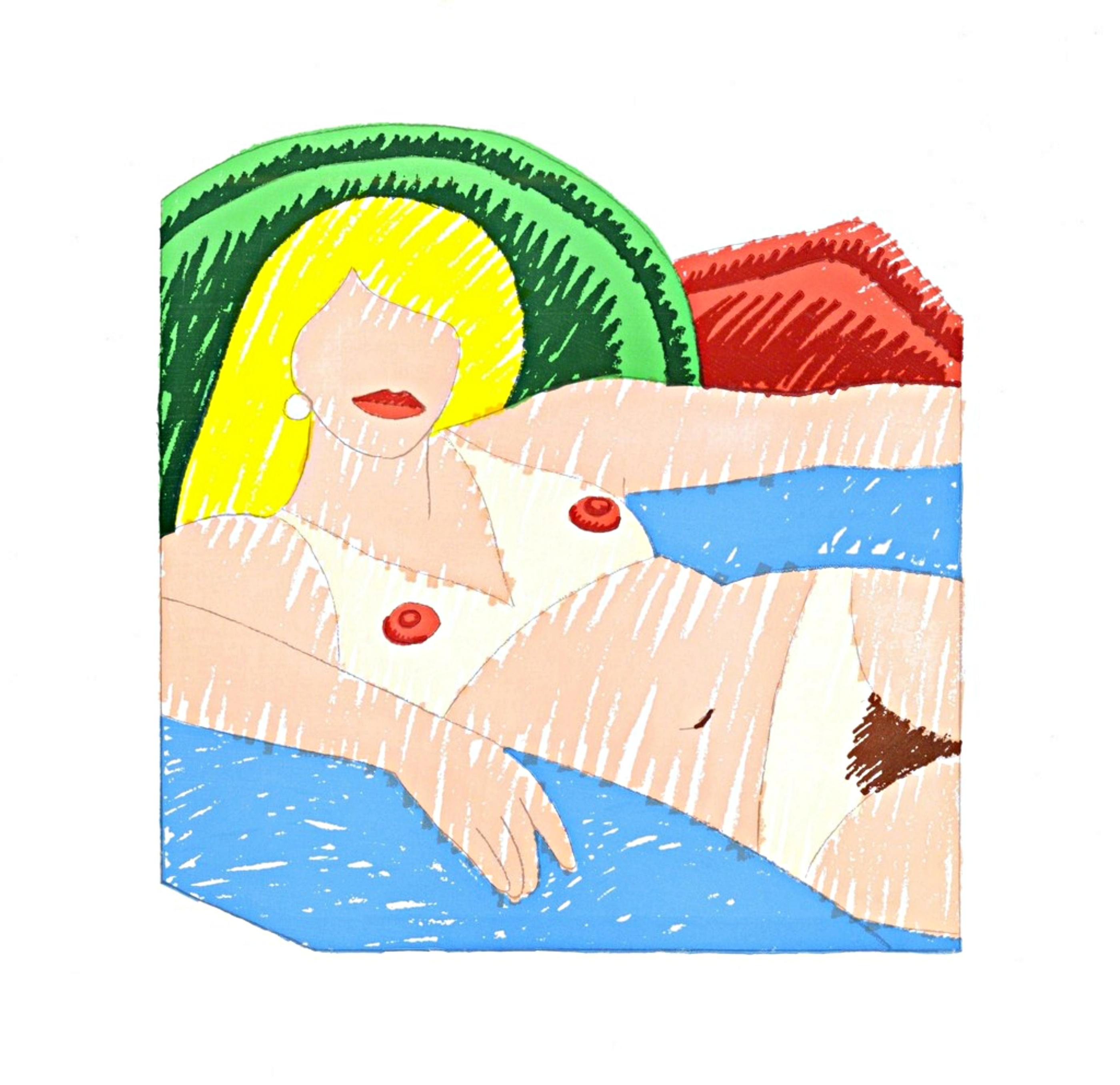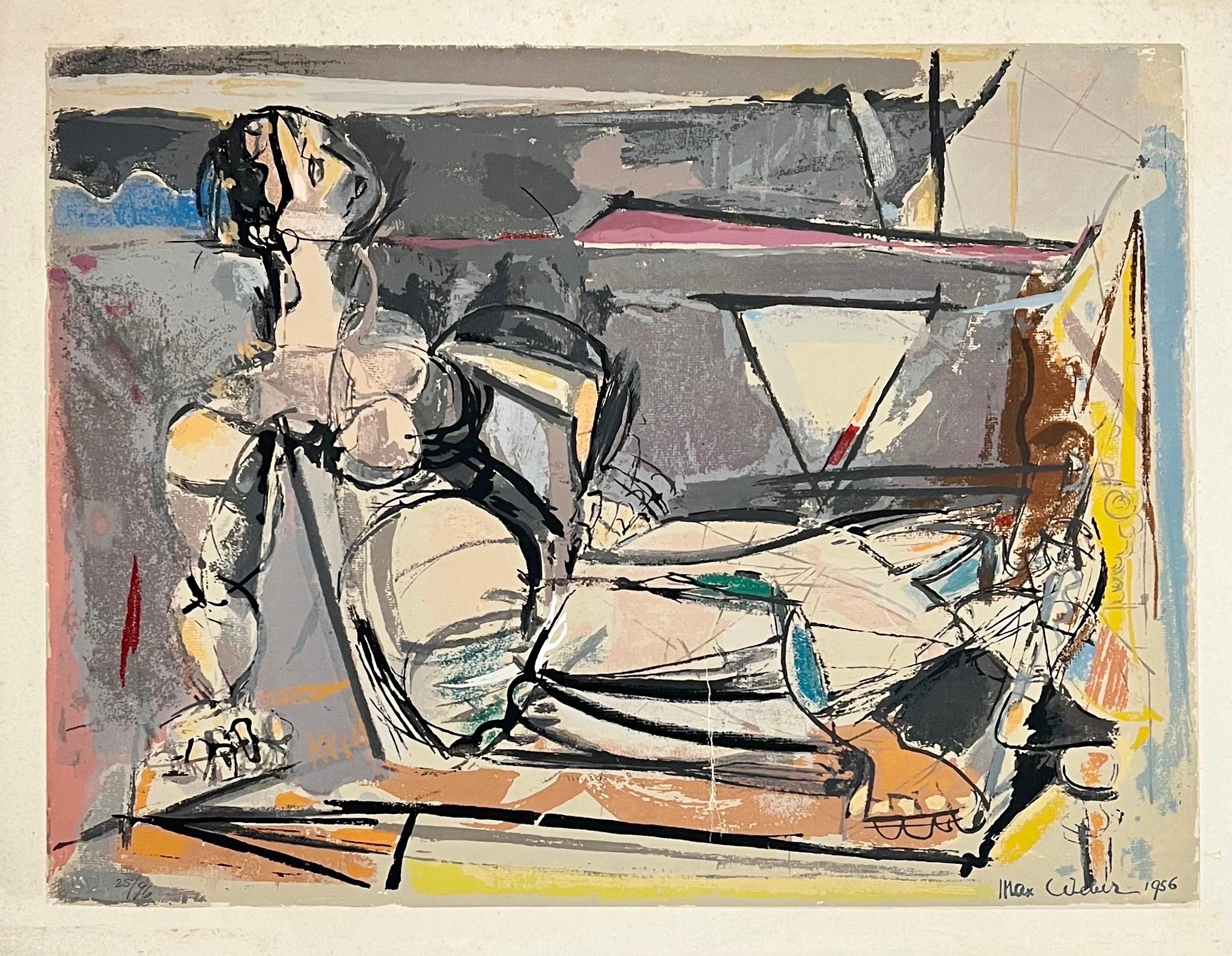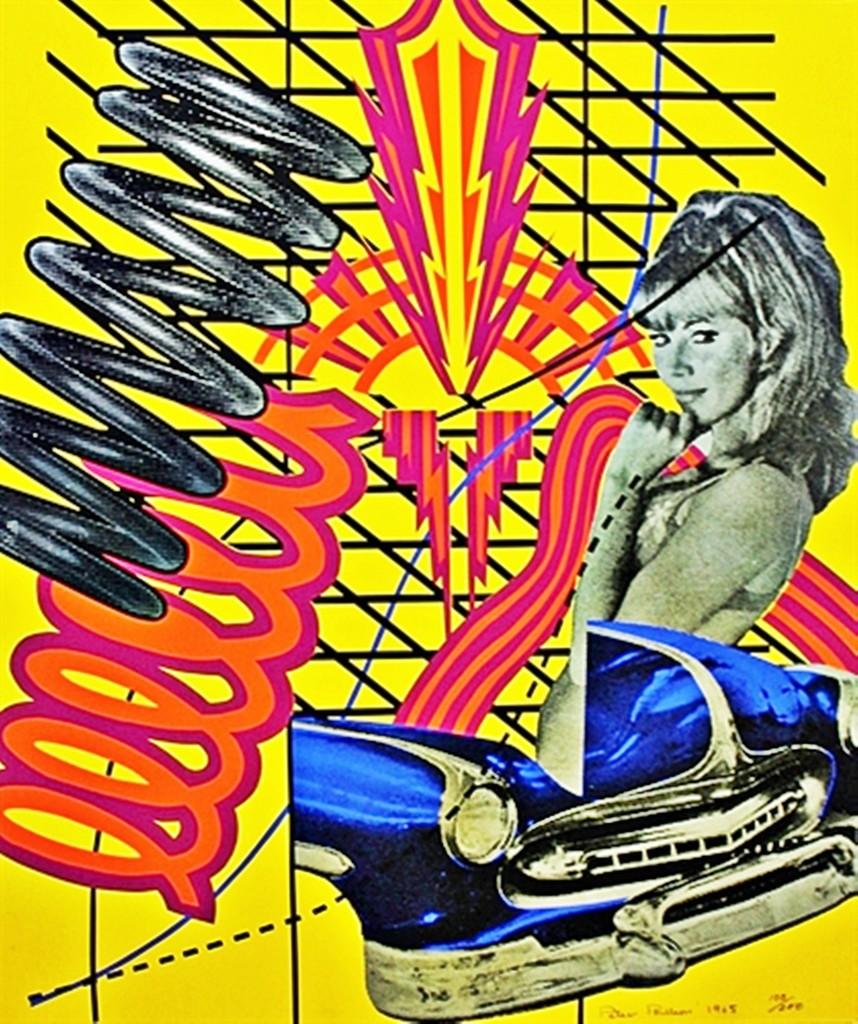Items Similar to Kabbalah
Want more images or videos?
Request additional images or videos from the seller
1 of 6
Richard MeierKabbalah2011
2011
About the Item
Richard Meier
Kabbalah, 2011
Silkscreen collage with hand-coloring and photography
sheet size: 30" x 30"
signed numbered dated in pencil by the artist
edition of 50
Richard Meier, (b.1934) most know as the world renowned architect began making collages almost 55 years ago, as a young student in Rome collecting crumpled papers and other detritus he found strewn throughout the city's ancient streets. [...] Meier joins a rich tradition of architects devoted to the art of collage—including Mies van der Rohe's De Stijl-inflected outings, Archigram's and Superstudio's psychedelic utopian visions, and OMA's postmodernist mashups. Collaging, after all, is a practice that, like architecture, involves the manipulation of space, the juxtaposition of materials, and a considerable amount of world-building.
- Creator:Richard Meier (1934, American)
- Creation Year:2011
- Dimensions:Height: 30 in (76.2 cm)Width: 30 in (76.2 cm)
- Medium:
- Movement & Style:
- Condition:Full portfolio available.
- Gallery Location:New York, NY
- Reference Number:1stDibs: LU3261276173
About the Seller
5.0
Vetted Seller
These experienced sellers undergo a comprehensive evaluation by our team of in-house experts.
Established in 1996
1stDibs seller since 2013
654 sales on 1stDibs
Typical response time: 5 hours
- ShippingRetrieving quote...Ships From: New York, NY
- Return PolicyA return for this item may be initiated within 3 days of delivery.
More From This SellerView All
- KahirBy Richard MeierLocated in New York, NYRichard Meier Kahir, 2011 Silkscreen Collage (mix media), sheet size: 30" x 30" signed numbered dated in pencil by the artist edition of 50 Richard Meier, (b.1934) most know...Category
2010s Contemporary Figurative Prints
MaterialsMixed Media, Screen
- IglioBy Richard MeierLocated in New York, NYRichard Meier Iglio, 2011 Silkscreen collage with hand-coloring and photography sheet size: 30" x 30" signed numbered dated in pencil by the artist edition of 50 Richard Meie...Category
2010s Contemporary Nude Prints
MaterialsMixed Media, Screen
- Guo Wei, Tireur de Pistolet No. 4By Guo WeiLocated in New York, NYGuo Wei, Ami No. 4 Tireur de Pistolet No. 4, 2009 Silkscreen Edition of 200 35 x 40.5 in. (88.9 x 102.9 cm.) Guo Wei (Chinese, b.1960) was born in Chengdu, Ch...Category
21st Century and Contemporary Contemporary Figurative Prints
MaterialsScreen
- Guo Wei, Ami No. 4By Guo WeiLocated in New York, NYGuo Wei Ami No. 4, 2009 24 color screenprint Edition of 200 35 x 40.5 in. (88.9 x 102.9 cm.) Guo Wei (Chinese, b.1960) was born in Chengdu, China, where he cu...Category
21st Century and Contemporary Contemporary Nude Prints
MaterialsScreen
- Regardless the Object Described Minutely, Digital PaintingBy Carla GannisLocated in New York, NYCarla Gannis is an artist who lives and works in Brooklyn, New York. Her work examines the narrativity of 21st century representational technologies and questions the hybrid nature o...Category
21st Century and Contemporary Contemporary Nude Prints
MaterialsArchival Pigment
- Eric Fischl, , Two Girls DancingBy Eric FischlLocated in New York, NYTWO GIRLS DANCING Year: 2011 Medium: 2-color lithograph Size: 27 x 30 inches (69 x 76 cm) Edition: 100 Price: $1,900 Born in New York City in 1948, Eric Fischl grew up in the suburbs of Long Island , his parents having moved there shortly before his second year.”Safer place to raise a family”, they used to say. Against a backdrop of alcoholism and a country club culture obsessed with image over content, Fischl became focused on the rift between what was experienced and what could not be said. Until the late 70’s, suburbia was not considered a legitimate genre for art. With his first New York show at the Edward Thorp Gallery, epithets like “psycho-sexual suburban dramas” became velcroed to his disturbing images of dyfunctional family life. Fischl began his art education in Phoenix, Arizona where his parents had moved in 1967. First at Phoenix Junior College, then a year at Arizona State University, and finally getting his BFA in 1972 at the recently opened California Institute of the Arts in Valencia, California. After graduation he moved to Chicago where he worked as a guard at the Museum of Contemporary Art. It was in Chicago that Fischl was exposed to the non-mainstream art of the Hairy Who. “The underbelly, carnie world of Ed Paschke and the hilarious sexual vulgarity of Jim Nutt...Category
2010s Contemporary Figurative Prints
MaterialsLithograph
You May Also Like
- Shiny Nude (Stealingworth, 33)By Tom WesselmannLocated in New York, NYTom Wesselmann Shiny Nude (Stealingworth, 33), 1977 Silkscreen on glossy cast-coated Kromekote paper 8 × 8 inches Edition 489/1000 Pencil numbered 489/1000 with artists printed name on the verso; Held in original stamped envelope Distributed by the Museum of Modern Art; printed by Unity Engraving Co. Unframed "Shiny Nude" - a dazzling limited edition, pencil numbered print features all of the hallmarks of the risque art arising from the sexual revolution of the 1960s and 1970s- saturated lips, full pubic hair...Category
1970s Pop Art Nude Prints
MaterialsScreen
- Silkscreen Surrealist Pop Art Print "Pas De Deux"By Michael KniginLocated in Surfside, FLPrint without matte is 19" X 13". Michael Knigin was born in 1942 in Brooklyn, NY. He attended and graduated from Tyler School of Art, Temple University. He received a Ford Founda...Category
21st Century and Contemporary 85 New Wave Abstract Prints
MaterialsScreen
- American Modernist Cubist Lithograph Screenprint "Reclining Woman" Max WeberBy Max WeberLocated in Surfside, FLReclining Cubist Nude Woman Max Weber (April 18, 1881 – October 4, 1961) was a Jewish-American painter and one of the first American Cubist painters who, in later life, turned to more figurative Jewish themes in his art. He is best known today for Chinese Restaurant (1915), in the collection of the Whitney Museum of American Art, "the finest canvas of his Cubist phase," in the words of art historian Avis Berman. Born in the Polish city of Białystok, then part of the Russian Empire, Weber emigrated to the United States and settled in Brooklyn with his Orthodox Jewish parents at the age of ten. He studied art at the Pratt Institute in Brooklyn under Arthur Wesley Dow. Dow was a fortunate early influence on Weber as he was an "enlightened and vital teacher" in a time of conservative art instruction, a man who was interested in new approaches to creating art. Dow had met Paul Gauguin in Pont-Aven, was a devoted student of Japanese art, and defended the advanced modernist painting and sculpture he saw at the Armory Show in New York in 1913. In 1905, after teaching in Virginia and Minnesota, Weber had saved enough money to travel to Europe, where he studied at the Académie Julian in Paris and acquainted himself with the work of such modernists as Henri Rousseau (who became a good friend), Henri Matisse, Pablo Picasso, and other members of the School of Paris. His friends among fellow Americans included some equally adventurous young painters, such as Abraham Walkowitz, H. Lyman Sayen, and Patrick Henry Bruce. Avant-garde France in the years immediately before World War I was fertile and welcoming territory for Weber, then in his early twenties. He arrived in Paris in time to see a major Cézanne exhibition, meet the poet Guillaume Apollinaire, frequent Gertrude Stein's salon, and enroll in classes in Matisse's private "Academie." Rousseau gave him some of his works; others, Weber purchased. He was responsible for Rousseau's first exhibition in the United States. In 1909 he returned to New York and helped to introduce Cubism to America. He is now considered one of the most significant early American Cubists, but the reception his work received in New York at the time was profoundly discouraging. Critical response to his paintings in a 1911 show at the 291 gallery, run by Alfred Stieglitz, was an occasion for "one of the most merciless critical whippings that any artist has received in America." The reviews were "of an almost hysterical violence." He was attacked for his "brutal, vulgar, and unnecessary art license." Even a critic who usually tried to be sympathetic to new art, James Gibbons Huneker, protested that the artist's clever technique had left viewers with no real picture and made use of the adage, "The operation was successful, but the patient died."[8] As art historian Sam Hunter wrote, "Weber's wistful, tentative Cubism provided the philistine press with their first solid target prior to the Armory Show." The Cellist...Category
Mid-20th Century Cubist Abstract Prints
MaterialsScreen
- Custom Print I (from 11 Pop Artist, Volume I) I Dream of Jeannie & Blue CarBy Peter PhillipsLocated in New York, NYPeter Phillips Custom Print I (from 11 Pop Artist, Volume I), 1965 Silkscreen on foil coated paper 24 × 20 inches Pencil signed, dated and numbered 100/200. Unframed This dazzling, ...Category
1960s Pop Art Nude Prints
MaterialsScreen
- Keith Haring Theater der Welt Frankfurt (Keith Haring 1985)By Keith HaringLocated in NEW YORK, NYKeith Haring, Theater der Welt Lithograph, Frankfurt, Germany 1985: Original 1st printing produced during Haring's lifetime. Bold, stand-out colors that make for brilliant, largely s...Category
1980s Pop Art Nude Prints
MaterialsScreen
- Untitled Plate 7 from Paroles Peintes Suite - 1970s - Sebastián MattaBy Sebastian MattaLocated in Roma, ITUntitled Plate 7 from Paroles Peintes Suite is an etching and aquatint on Japon paper. Hand-signed and hand-numbered in pencil on the lower margin. Edition of 85 prints. Perfect con...Category
1970s Contemporary Abstract Prints
MaterialsEtching, Aquatint
Recently Viewed
View AllMore Ways To Browse
Rome Architecture Prints
Meier Richard
Psychedelic Collage
Van De Rohe
Richard Ago
Screen Print Ancient
Kabbalah Art
Mies Van Der Rohe Print
Mies Van Der Rohe Photography
El Salvador Vintage
Joan Miro Lithography
Kinetic Vasarely
Vintage Joan Miro
Damien Hirst White
Monoprint 1990
Retro Print Revival
Lithograph Airline
Robert Motherwell Signed Lithographs





